Understanding the impact of hotel digital concierges on customer satisfaction
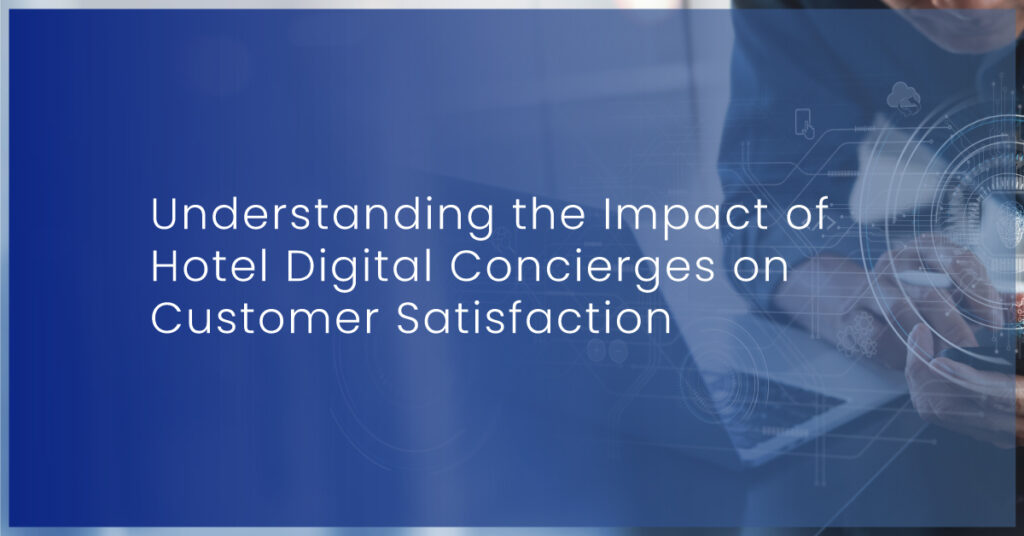
Hotel digital concierges are becoming increasingly popular for hotels to provide personalized service to their guests. To put it simply, a digital concierge is a computer program or app that helps guests navigate their stay at a hotel by providing information about the hotel’s amenities, local attractions, and other services. These digital concierges can be accessed through a hotel’s website or app and often offer an AI-based conversational chat that allows guests to ask questions and receive immediate answers. One of the key benefits of using digital hotel concierges is that they are available 24/7, allowing guests to get the information they need at any time of day. The digital concierges are also a great value addition for guests in a new city looking for recommendations on where to eat or what to do or getting answers to how they can utilize the property’s amenities. What are the prerequisites for using hotel digital concierges? While digital hotel concierges can undoubtedly be helpful for guests, hotels must ensure that they are implemented and used effectively. A poorly designed or difficult-to-use digital concierge can frustrate guests and negatively impact their in-hotel experience. Therefore, hotels need to conduct user testing and gather feedback on their digital concierge to ensure that it meets the guests’ needs. The exercise is critical because if your digitalization efforts are ineffective, it can be frustrating for guests and may lead to counterproductive business outcomes. So, once you have sufficient data that justifies that your digital concierges can provide quick and accurate responses to guests’ questions and needs, you can go full throttle. Some of the initial benefits of introducing digital concierges include: Reduced workload on front desk staff: By using a digital concierge, you can allow your front desk staff to focus on other tasks that require human touch like upselling. Data collection: Digital concierges also help you gather strategically important data on your guests, which can be used to improve the guest experience and increase satisfaction. Eventually, when your digital concierges hit the ground running, you will also witness your operations picking up pace. Speed is the currency for hospitality businesses. As Eric Pearson of International Hotel Group (IHG) says, “It’s no longer the big beating the small, but the fast beating the slow” The Impact of Hotel Digital Concierges on Customer Satisfaction According to a study conducted by Oracle Hospitality, hotels that implemented a digital concierge saw an average increase of 8% in guest satisfaction. Additionally, guests who used the digital concierge had a 10% higher rate of return and a 15% higher rate of recommendation to friends and family than those who did not use the digital concierge. So, it’s statistically proven that digital concierges make business sense. Therefore, it’s important to study the touch points where the concierges directly influence customer satisfaction. Here we analyze five major impact areas where digital hotel concierge better customer experience. Prompt Assistance With a digital hotel concierge, such as branded app installed on in-room iPad, guests can access immediate assistance at any time of day or night. Whether they have a question about their hotel stay or are looking for recommendations on things to do or see in the local area, they can receive a response promptly. It can significantly enhance a guest experience, allowing them to get the information they need without waiting for a response from hotel staff or trying to find it on their own. Personalized Recommendations One of the key advantages of digital hotel concierges is that they can provide personalized recommendations based on a guest’s preferences and past behaviors. For example, the same in-room iPad used for guest support can suggest nearby restaurants that serve the type of cuisine the guest prefers or recommend activities based on the guest’s interests. This level of personalization can make the guest feel valued and appreciated, leading to a more enjoyable and satisfying stay. Convenient Reservations for nearby attractions and events With a digital concierge-like WhatsApp automation, hotels can provide guests links to book tickets for nearby attractions, which also opens a revenue opportunity for hotels. It allows guests to easily make reservations or purchase tickets for events or attractions from their own devices. It saves them time and effort, as they don’t have to call or visit the hotel front desk to do so. Timesaving Hotel digital concierges like real-time brochures help guests save time by providing all the information they need in one place. Rather than searching for information about the hotel’s amenities or local attractions on multiple websites or asking hotel staff for assistance, guests can access the digital concierge for all the information they need. Custom Itineraries Some hotel apps offer the in-app ability to create customized itineraries for guests, allowing them to efficiently plan their stay and make the most of their time in the local area. It can be beneficial for guests who are visiting a new city and want to ensure they take advantage of all must-see sights or activities. Conclusion! Hotel digital concierges are a valuable addition to the modern travel experience. Not only do they provide guests with convenient access to information and assistance, but they also offer the potential for increased satisfaction and loyalty. From personalized recommendations and time-saving convenience to the ability to make reservations and purchase tickets, these digital tools have the power to enhance the guest experience greatly. While hotels must ensure that their digital concierge is user-friendly and provides accurate information, the benefits of implementing these tools far outweigh any potential challenges.
How does a conversational AI Chatbot work? Use cases in Travel
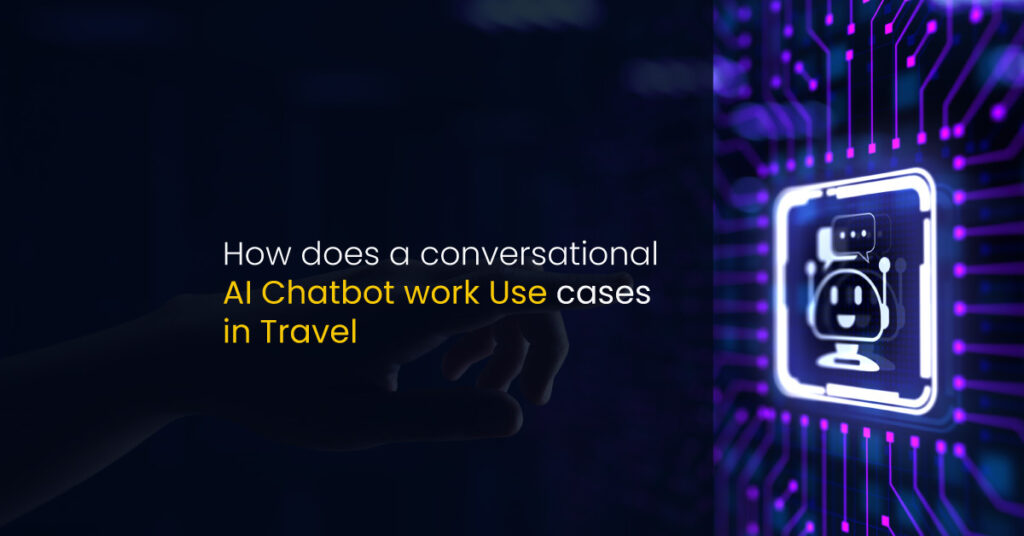
Travel & accommodation is a highly customer-facing industry. At the same time, the volume of travelers is big and traveler expectations are bigger. As many as 100,000 flights take off every day, carrying about 6 million passengers. In short, it’s not a mean task to serve a satisfactory customer experience in an industry as dynamic as travel. Therefore, in the travel industry, there was always a pressing need for automation in customer service. Conversational AI chatbots are greatly serving the travel industry in automating customer service functions. Here, in this article, we will discuss how the whole technology of conversational AI and the bots running on it work. Also, explore emerging and popular use cases of technology in the travel industry for chatbots. How does a conversational AI chatbot work? Think of a conversational AI chatbot as a computer program that can have conversations with human beings. It is usually programmed to answer questions, but it can also be programmed to carry out tasks. The purpose of a conversational AI chatbot is to simulate human-to-human interaction as closely as possible in order to provide the most efficient and effective customer service. It reduces the burden on human customer support executives, they can direct their energies to questions that are more critical and necessarily require human intervention. The travel businesses are now increasingly employing conversational AI chatbots and voice bots to address customers’ queries. Many are calling them “Robo Travel Advisors.” They are helping customers through their journey and becoming end-to-end assistants. Top benefits of using AI travel chatbots Like other travel businesses, conversational AI chatbots can also provide impetus to your customer service efforts. Still, have doubts? Let us declutter them by exploring the top benefits of implementing AI chatbots in travel. Reservation Assistance When customers initiate a booking and shop around options, they tend to develop doubts in their minds. So, the whole journey from interest to finally making a booking decision at many junctures mandates them to interact with either a customer support executive or write to your travel portal. That’s when the function of AI chatbots comes, you know your offerings, and you know the possible apprehensions of travelers. You can train your chatbot with the required information and have your AI chatbot work as an efficient reservation assistant. Booking Manager The conversational AI chatbots today can communicate and respond to travelers with all the necessary information in a similar tone using natural language processing. Moreover, chatbots can make real-time booking modifications, like rescheduling, canceling, or processing refund requests. Also, keep customers updated in scenarios like flight delays due to sudden weather changes, last-minute booking modification requests, and all other dynamic travel requests. So, your AI chatbot can work as a booking manager and deliver quality customer experience across customer touchpoints. Round-the-clock engagement and personalization Travel is a dynamic industry. Customers often need instant help, even if they are in different time zones. AI chatbots can be available 24*7 *365 days a year. Constant availability of customer support enhances the customer experience. As per a Deloitte survey, 92% of the brands see customer experience as a differentiator. Also, the conversation AI chatbot can offer personalized recommendations while helping the customers, creating additional revenue opportunities for your travel business. Data and feedback mechanism AI chatbots also offer a great degree of convenience to customers; they can easily track the communication and access the data they have shared in the chat, especially in cases that require continuous follow-ups. Also, this data is nothing less than a treasure if you look at it in a business sense. You can use the data to create a concrete feedback mechanism. And conduct market research on how your products and services are performing largely. Also, based on conversations, you can offer personalized offerings to your customers. Resolving vague questions Customers do not always ask straight, corrigible questions. With the help of NLP (natural language processing), AI chatbots can make sense of vague queries like “beach la party” or “music live hotel.” The bot identifies the triggered words and searches for the customer’s query to display the best answer. Recommended: Five Ways To Measure The Effectiveness Of Hotel Chatbot Conclusion! The conversational AI chatbots enhance the overall customer experience. And in an industry like travel, the volume of routine queries is larger than unique ones. At times travelers just want to know luggage requirements or room policies. Therefore, AI Chatbots can be a sustainable, affordable ally to your customer service efforts. You can have a leaner customer service staff that caters to queries requiring human involvement.
Calculating a property’s performance: RevPAR, ADR, Occupancy Rate – Learn these hotel metrics and formulae
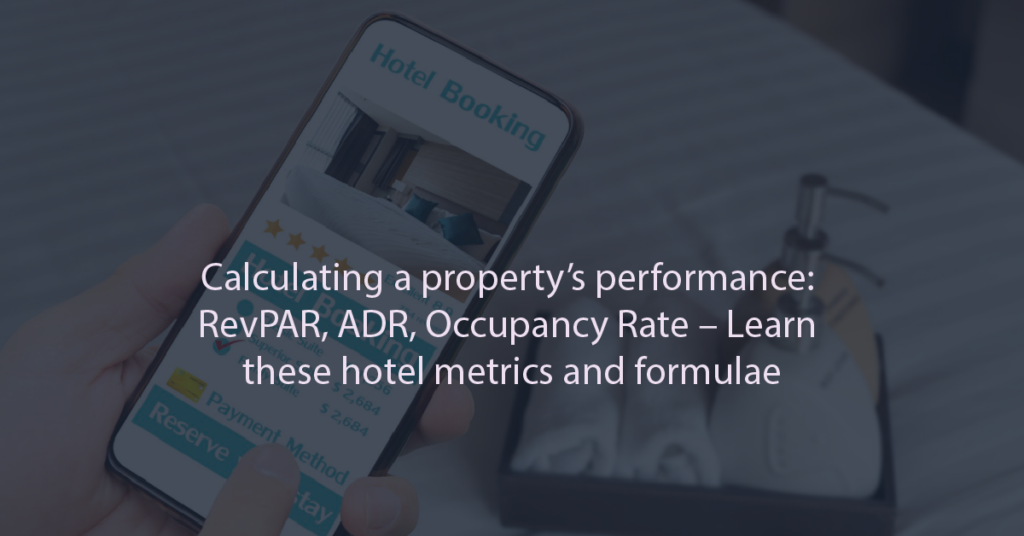
Running a successful hotel business is more than just providing a comfortable bedroom and great customer service. To have a detailed understanding of how your accommodation business is faring now, what you can expect in the future, and what are areas of improvement. You need to be on top of critical hotel metrics. These metrics help you make informed business decisions and most importantly benchmark against competitors. In this article, we will explore these key hotel metrics in detail, explain how to calculate them, and offer some suggestions on how to improve them for the benefit of your hotel business. Now that we understand the importance and benefits of tracking hotel metrics, let’s take a closer look at the three key metrics – Revenue Per Available Room (RevPAR), Average Daily Rate (ADR), and Occupancy Rate. Revenue Per Available Room (RevPAR) RevPAR is the most widely used hotel metric in the industry. It measures the total revenue generated by a hotel per available room. To calculate RevPAR, take the total revenue generated by the hotel and divide it by the total number of available rooms. The result is the average revenue per available room. This metric helps you understand how much revenue is generated on a daily basis. RevPAR is an important metric because it takes into account both the occupancy rate and the average daily rate. A hotel can have a high occupancy rate but a low average daily rate, which would result in a lower RevPAR. On the other hand, a hotel can have a low occupancy rate but a high average daily rate, which would result in a higher RevPAR. By tracking RevPAR, you can determine whether they need to adjust their pricing strategy or marketing efforts to increase revenue. Average Daily Rate (ADR) ADR is the average rate paid for each room sold in a hotel. To calculate ADR, divide the total room revenue by the number of rooms sold. This metric is used to track a hotel’s pricing strategy and can help identify changes that need to be made. ADR is a key metric because it helps you understand how much guests are willing to pay for a room. By tracking ADR, you can adjust their pricing strategy to increase revenue without sacrificing occupancy. A hotel with a high ADR can generate more revenue with fewer rooms sold than a hotel with a low ADR. Occupancy Rate Occupancy Rate is the percentage of available rooms that are occupied. To calculate, divide the number of occupied rooms by the total number of available rooms. This metric helps you understand how well the hotel is attracting customers and filling available rooms. Occupancy Rate is an important metric because it directly impacts a hotel’s revenue. A hotel with a high occupancy rate can generate more revenue than a hotel with a low occupancy rate, even if they have the same ADR. By tracking occupancy rate, you can adjust their marketing efforts to attract more guests and increase revenue. However, it’s important to note that a high occupancy rate doesn’t always mean a hotel is performing well. If a hotel is consistently selling out of rooms, they may need to increase their rates to maximize revenue. On the other hand, if a hotel has a low occupancy rate, they may need to adjust their marketing efforts or pricing strategy to attract more guests. Now, let’s move on to the calculation part, RevPAR and ADR require additional explanation, let’s look at them one by one. Stick around! Calculating Revenue Per Available Room (RevPAR) Calculating RevPAR is a simple process that starts with determining the hotel’s total revenue for a given period, including revenue from rooms, food and beverage, and other sources. Next, you will need to determine the number of available rooms during the same period. Once you have both numbers, divide the total revenue by the number of available rooms. The result is the RevPAR for the given period. The RevPAR Formula First, calculate the total revenue generated by the hotel for a given period. Next, determine the total number of available rooms for the same period. Divide the total revenue by the total number of available rooms. Analyzing RevPAR Results Once you have calculated your RevPAR, it’s important to analyze the results. If your hotel’s RevPAR is low, it may indicate that your pricing or marketing strategy needs to change. For example, you may need to lower room rates or increase marketing efforts to attract more customers. By analyzing RevPAR, you can identify areas for improvement and make changes to improve your hotel’s performance. Calculating Average Daily Rate (ADR) Calculating ADR is also a simple process that starts with determining the hotel’s total revenue for rooms for a given period. Next, determine the number of rooms sold during the same period. Once you have both numbers, divide the total revenue by the number of rooms sold. The result is the ADR for the given period. The ADR Formula First, calculate the total revenue generated by the hotel from room sales for a given period. Next, determine the total number of rooms sold for the same period. Divide the total revenue by the total number of rooms sold. Analyzing ADR results Keep in mind that several factors can affect a hotel’s ADR, including market demand, competition, seasonality, and amenities. By understanding these factors, you can make informed decisions about pricing and marketing strategies that can improve your hotel’s net ADR. Metrics such Revenue Per Available Room (RevPAR), Average Daily Rate (ADR), and Occupancy Rate are used to track a variety of performance indicators. We will discuss them in detail later in this post. But before we move to those explanations, let’s first get clarity on why these metrics are important in a larger scheme of things. Facilitating Decision Making One of the most important benefits of using hotel metrics effectively is to support decision making with data. For example, if a hotel’s occupancy rate is low, it may indicate that the hotel needs to lower its prices or improve its marketing efforts.
Why hotel rate shopping software is pivotal to strategize pricing?
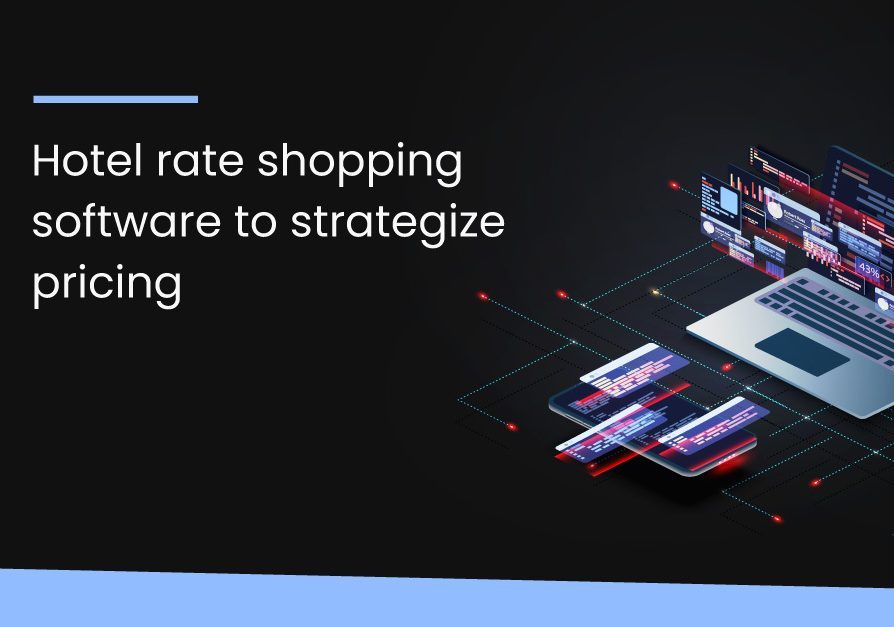
Hotel rate shopping software is a price analysis tool for hotels. It offers real-time rate intelligence and makes revenue management easy in a highly rate-sensitive hotel market. Here in this article, we’ll evaluate the role of hotel rate shopping tools in overall pricing strategy of hotels. Room rate is one of the key decision drivers in your business. It could simply be the reason why an individual chooses to go with you over your competition. Setting room rates is an intricate game; you need to gauge many variables and factor in market sentiment to come up with room prices. And to price room rates competitively, you need hotel rate shopping software. What is this tool? How does it function? And how it can help you strategize your hotel room prices better is what we are going to discuss in this post in greater detail. We will explore all the tool’s possibilities and the features you need to know before employing this tool in your business. So let us start with understanding the basics of this tool. What Is Hotel Rate Shopping Software? A Hotel Rate shopping tool does precisely what its name suggests. It helps you shop around for the rates of different hotels, including your competitors. It offers you insight into two critical variables of hotel room pricing – Rate Visualization and Rate Parity. Analysis of these two variables will form the foundation of your pricing strategy. Almost all rate shopping tools have filters that offer more micro details like a city-level view, area-level view, etc. Also, you can check your online ranking based on your current pricing structure. But what are Rate Visualization and Parity? Sound like jargon? Let’s break them down. a) Rate Visualization Hotel Rate Shopping Software will give historical rates and rate predictions of the hotels in your category, including your hotels. You can use the tool to visualize your rate for each room category for every day of the year and match those rates with your competition. The whole exercise put together is called “rate shopping.” b) Rate Parity The rates you see in the rate visualization module of a Hotel Rate Shopping software are crude, advertised rates. After checking out, an individual’s actual payment could vary hugely from the advertised rate. Therefore, making pricing decisions solely based on visualization will be premature. That’s why you need insights into Rate Parity. What’s Rate Parity? Rate parity is a cumulative comparison of room rates where every room component is compared with similar room components of other hotels. The breakdown of rate parity gives you a clear picture of what other hotels in your category are charging. With a hotel rate shopping tool, you can get comparable rate parity data of any hotel, inside or outside your competition. By now, you would be convinced that the rate shopping tools have value when it comes to knowing where your pricing stands compared to your competitors. But does it help in strategizing the long-term pricing of hotel rooms? The answer is a resounding yes. Next up, we are helping you explore use cases of hotel rate shopping tools that help you with a long-term pricing strategy. How to use Hotel Rate Shopping Software for Competitive Pricing? Devising a sustainable competitive pricing strategy using rate shopping tools is not a demanding task. All you need to do is use the data pulled by your rate shopper to your advantage. When you use a hotel rate shopper, you may uncover a lot of surprising data that you can use for your competitive edge. Here we are helping you by citing some possible use cases that can directly benefit you; if not, you can use them as a reference point to devise your own pricing strategy. a) Counter Pattern Once you employ the rate shopper tool, you will find most hotels have a pattern in their pricing. Many hotels will be using the BAR pricing module, which we won’t recommend if you are using a rate shopper tool. Cutting the chase, you will have to study and identify patterns in your competitors’ pricing, understand when they hike when they lower their prices and prepare a counter pattern of pricing that works for your advantage. b) SWOT Analysis Using rate shopper software for SWOT analysis of your existing pricing strategy can work wonders for you. You can start by comparing your online standings with your competitors. If you lack, you know what to do. If you don’t, market your standings and leverage them in pricing. Now you know the drill, you can explore many similar opportunities for better pricing and correction. c) Unearth the Unknown The odds are high that you don’t know where you outperform your competitors, as hotel room rates change like the values of stocks change in exchanges. We talked about patterns earlier. And here we take you to the point where you are breaking down rate parity and the numbers you unearthed through visualization. If you find you are outperforming your competitors in any category, you can use transparent pricing in that category, which is rare in the hotel industry. It will serve well both your marketing and sales objectives. Recommended: What is Loyalty SaaS Solution | Know different Vendors in the Travel Market There are no two thoughts about the insights hotel rate shopping software provides through rate visualization and parity modules. It helps you maneuver your day-to-day pricing. Also, as we mentioned, hotel rate shopper tools can be monumental in strategizing a long-term pricing strategy for your hotel. You can use the cases we mentioned as reference points and take the lead.
What is hotel upsell software? And how to choose one?
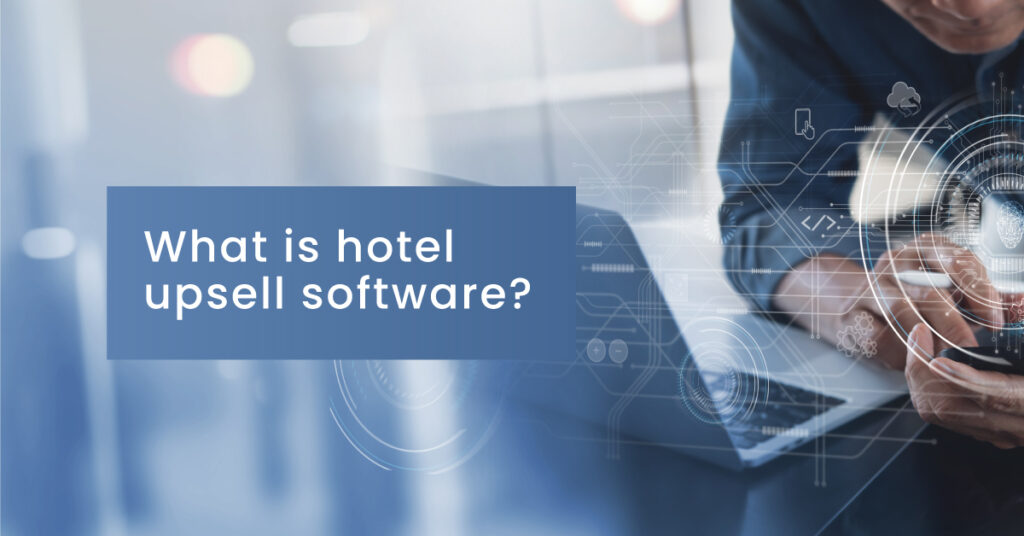
Hotel upselling software allows you to automate your upselling of hotel products & services using various communication channels and integrations. This article will explore how this tool works, factors to consider before choosing one, and some top solutions you must consider. Regardless of the hotel property type you handle; you need strategies and techniques to maximize your revenues from your existing customers; upselling is one of those crucial techniques that help you achieve this goal without affecting the customer experience. So, what’s upselling? It’s basically a method of convincing already interested customers to buy additional products and services at added cost. In the hotel industry, there are many ways and opportunities to do upselling. For example, you can offer customers a room upgrade before they check-in, or if you offer packages, you can upsell them by providing other amenities not included in the package. However, finding these opportunities and executing hotel upselling is a demanding task. That’s when the need for automating hotel upselling tasks presents itself, and hotel upselling software does it for you. What does a hotel upselling software do? As mentioned previously, the primary role of hotel upselling software is to automate upselling of hotel products and services. Having said that, how does this software achieve this automation, and how effective is it? Let’s try to answer it. The tools use different communication channels to reach guests with highly customized targeted offerings at various points of their journey. Many of these tools integrate post-stay guest communication with major travel review platforms like Trip Advisor, which becomes a reference point for other customers. Every user engaging with these reviews is a potential customer; the tools identify these individuals and groups and send upsell offers once they make a booking. The process eliminates the need for manual “upsell communication” from front desks. By now, you would be convinced about the utility of hotel upsell software. Yet an obvious thought that might strike your mind, which is, “are all hotel upselling tools good?” Not actually. Like all software solutions, there are good and bad hotel upsell tools. So how do you choose one? Next up, we are helping you with that by listing five critical components of the hotel upselling tool. Factors to consider for hotel upselling software The needs and requirements of different hospitality businesses vary. There is no one size fits all kinds of solution. Here we outline the essential features of hotel upselling software that will help you choose the right solution for your business. Availability of multiple communication channels Your upselling tool must offer you multiple guest communication channels that you can leverage to contact guests at various touch points of their journey. The software should at least offer communication capability with emails, chatbots, text messages, and live chats. Personalization suite Personalization rests at the core of any hotel upselling software. It should have provisions for dynamic room upgrade pricing, offer customization, and offer personalization. Automation capability Throughout this article, we have put thrusts on automation. Your hotel upselling tool must be able to automatically send offer emails, texts, and communication regarding offer redemptions and confirmations. Exclusion module Segmentation of interested and non-interested guests is crucial. Your hotel upselling software must have a module to perform this segmentation. And offer an exclusion module where you can list all the non-interested guests. Multidevice useability Your guest can use any device to book or modify their stay. And you never know the device they would use during their stay. Therefore, your hotel upselling tool should offer usability with all gadgets, laptops, smartphones, and tablets. 3 Prominent solutions to consider To choose a vendor for your hospitality business, you will have to factor in many variables like the size of your enterprise, the category of customers you deal with, etc. So, without delving into those variables or promoting any specific tool, we list the prominent vendors that fare well on the factors we mentioned above. EasyWay Easyway digitally tracks end-to-end customer journeys and pushes personalized upselling offers through popular messaging apps like WhatsApp, WeChat, iMessage, and other similar applications. Revinate Revinate’s USP is to offer hyper-personalized hotel products and services to targeted guests. The tool banks on establishing a deeper connection with the guest through its data-driven solutions to upsell hotel packages and room upgrades. Oaky Oaky is a commission-free hotel upselling engine that helps you easily automate upselling functions. It is one of those rare hotel upselling tools that gives guests absolute control over the deals they are getting from the hospitality businesses. The guests also get the flexibility to accept part offers. Recommended: What is loyalty SAAS solution Upselling is an excellent method to drive organic incremental revenues to any hospitality business. You offer additional value in exchange for an added cost, and there’s nothing unfair in this practice. Whereas upselling hotel products and services manually can trigger unpleasant customer experiences because you don’t have solid data to back your advances, and you don’t know if the guests are interested. Therefore, you need these hotel upselling tools that not only automate your hotel upselling processes but also ensure the function does not invite any bad customer experience. You can use the information in this article to select the right fit hotel upselling tool for your hospitality business.
40+ Different Hotel Content Attributes That Users Check Before Booking a Hotel
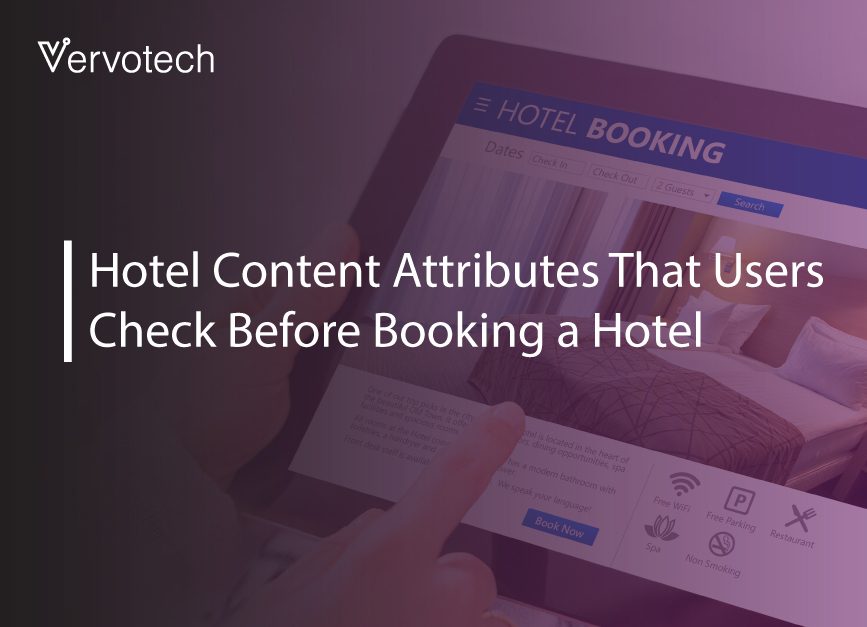
At a time when the majority of hotels are booked online, consumers try to find answers to their questions – what’s the pet policy, if smoking allowed or not, what are the pool hours, is there an in house restaurant – the information is nothing but hotel content and it should be accessible in minimal time because it takes only milliseconds for a user to switch to another website. While losing customers to competition because of operational inefficiency is something that you’d never want as an online travel business. Then, how to solve this conundrum? Can widening the set of attributes you display on your website solve this? Let’s find out! When the range of questions coming from consumers is widening, the set of answers you provide on your website should also widen. Although it’s understandable that data coming from multiple distribution channels is too cluttered to be displayed on websites. And keeping the hotel content data up to date all the time is another big challenge. To solve all the issues mentioned above on one platform, you need a dedicated master tool. A tool that maps the maximum number of attributes, so you can answer maximum customer queries upfront. There are Hotel Curated Content tools in the market that map up to 40+ attributes, allowing travel businesses to create sustainable travel businesses. These tools mostly run on AI/ML algorithms and keep your hotel content up-to-date with minimal human intervention. This empowers you to tell your best story to your potential customers. Now, let’s have a deeper look at how these 40+ hotel content attributes take form once mapped by a hotel curated content tool: Hotel Name: Online travel businesses work with multiple suppliers, and too often they end up mixing the hotel names, which creeps doubt into customer’s mind, and results in canceled or missed bookings. Top mapping tools use AI/ML algorithms to find out the correct name of the hotel and help you list accurate hotel names on your website. Property Type: Giving the consumer clarity about Hotel property types, such as – Motel, Resort, Villa, etc. attracts more customers, because when customers come online to book a hotel, they already have a property type in mind, if they don’t get the matching property or not enough clarity about the property type, they are likely to leave your hotel listing. Images: When it comes to hotel booking, images are key decision drivers. Hotel Curated Content tools provide image content through its network of exclusive hotel media content providers to make your hotel content completely ready for listing. Star Rating: With more customers going online, putting across their opinions on their travel experiences, star rating becomes very critical to establish the legitimacy and the quality of a property. Products like Hotel Curated Content map star ratings and provide strong social proof to properties. Email: To facilitate a smooth post-booking experience a Property’s email address is a very crucial denominator. There are scenarios when a user wants to connect directly to the hotel with their special requests, email addresses come very handy in those situations. Curated Content Tools accurately extract email addresses of properties from your suppliers’ data and add them to your hotel content. Geocodes: At a time when everyone owning a smartphone has access to GPS technology, not providing accurate geocodes can be very counterproductive for any travel business. Curated Content Tools add accurate geocodes to your hotel content by leveraging highly efficient AI/ML algorithms. Address Line1: Usually property addresses have two lines, to avoid any missing important address data, the hotel content mapping tools capture the full address in its natural form and list the first line of address in Line 1. Address Line2: Detailed location information of a property comes in Line 2 of the address. Country Code: HMC Tools map Country Codes provided by the International Organization for Standardization to avoid mix and match of country names in the content. Supplier Name: When you take services of multiple suppliers, you must know the name of the supplier providing that hotel. Supplier Hotel Id: You get access to a consolidated list of property IDs provided to you by your suppliers. Recommended: Hotel Data Duplication: How To Solve The Growing Challenge For Hospitality Industry City Name: Name of the city where the property is located. State Name: Name of the state where the property is located. State Code: Code of the state where the property is located. Zip Code: Zip Code of the area where the property is located. Country Name: Name of the country where the property is located. Latitudes and Longitudes: Latitude and Longitude of the property to get precise direction and location of the property. Phones: Property’s phone numbers. Fax: Property’s fax number. Website: Property’s official website address. As Hotel Content plays a very crucial role in the booking process, with a quality Hotel Curated Content tool, you can easily list all the aforementioned attributes properly on your travel website. And put your travel business in a position that allows you to present your best story to your potential customers, and also take your conversion numbers up north. Vervotech is a leading Hotel Mapping and Room Mapping API that leverages the power of AI and ML to quickly and accurately identify each property listing through the verification of multiple parameters. With One of the industry’s best coverage of 98% and an accuracy of 99.999%, Vervotech is quickly becoming the mapping software of choice for all leading global companies operating in the travel and hospitality industry. To learn more about Vervotech and the ways it can enhance your business in the long run contact us: sales@vervotech.com
Five ways to measure the effectiveness of hotel chatbot
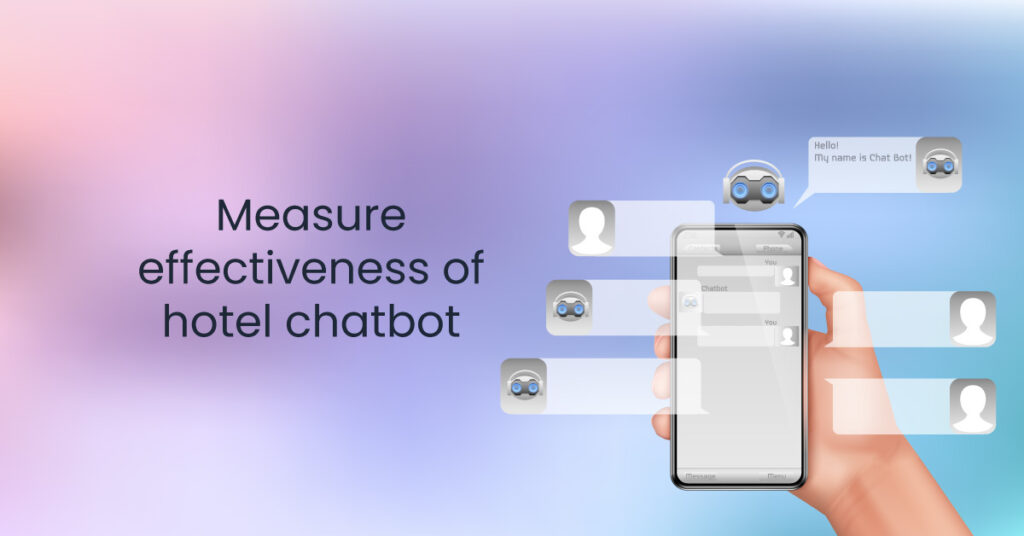
Key players in the accommodation industry are now increasingly using hotel chatbots powered by AI and NLP (Natural Language Processing) as digital customer service agents and for answering regular to critical customer questions. Here in this article, we’ll discuss how to measure these hotel chatbots’ effectiveness. “Thinking about the bot as a front-end representative of your product or service can make a lot of sense and having a delightful bot that provides a useful service can generate a strong attachment to your brand.” Amir Shevat Designing Bots: Creating Conversational Experiences Integration of hotel chatbot into business strategy reduces unwarranted pressure on human resources to answer customer queries that are either repetitive or frequently asked. But how do you know if your chatbot implementation is working? You need to have some yardstick to measure its success or failure. Right? You are reading this article means you are already using or thinking of hotel chatbots. No worries. Here in this piece, we’ll look at some tried and tested methods to measure the effectiveness of hotel chatbots. Five Key indicators to assess the performance of hotel chatbot Measuring and analyzing the correct performance indicators of your hotel chatbot will help you evaluate its actual ability to handle crucial customer conversations. Also, you will be able to gauge how and when you can implement your chat in your other business processes. There are loads of KPIs that you can measure. Here in this article, we will assess five key performance indicators crucial for the success of chatbots in the accommodation industry. So, let’s look at them one by one. 1. Conversation Success While assessing the performance of your hotel chatbot, the first indicator you should look at is the conversation success rate. If too many customers leave the chat unsatisfied, your bot needs tweaking. Issues could be anywhere between its placement or its ability to lead conversational interactions. It’s true that some issues mandatorily require human interaction. Yet you need to find out if users’ requests are correctly processed, e.g., If the interaction demands human interaction, is your hotel chatbot triggering a live agent at the correct time? These are the variables that you need to analyze while determining the conversation success of your hotel chatbot. However, the output of your chatbot is a summation of the information put in its database. So, to achieve better success, you need to broaden your database constantly. With a broader database, AI and NLP will be able to produce more quality output for your customers, and over time you will observe a better conversation success rate. 2. Bot Sessions It is an excellent metric for rule-based hotel chatbots to understand how much time your bot is taking to produce the desired results your users are seeking. The metric counts the total number of interactions sent and received. A lower bot session means the user is getting its query resolved in minimum steps and vice versa. Therefore, learning is simple; you always need to keep a close eye on “bot sessions.” At times, users leave a chat thinking a bot cannot solve their queries. If “bot sessions” are too low, you can observe random conversations and make sure your conversation success rate is going in the right direction. 3. Bounce rate The success of a hotel chatbot is co-related with the success of your website. If your users leave your website without even visiting your hotel chatbot, your bounce rate is high. And your chatbot is not even coming into the play. In cases of high bounce rate, the design, the content, the speed of your website, etc., everything comes under the scanner, and you need to work on these elements to reduce bounce rate. 4. Fallback Rate No chatbot is foolproof. No matter how broad your database is, it will not be able to satisfy 100 percent of consumers. That’s why you need to check your chatbot’s fallback rate. The fallback rate is nothing but the percentage value of the times your hotel chatbot fails to satisfy customer queries. The metric will give you numeric insights into the instances your bot could not understand customer requests. 5. Customer Satisfaction Ratings Customer satisfaction is pivotal to driving business growth. To measure how satisfied your customers are with your hotel chatbot, you can put in simple yes or no type questions. Also, you can ask visitors to rate conversations before they exit your bot. You can use these ratings as a yardstick to measure customer satisfaction. Recommended: How does a conversational AI Chatbot work? Use cases in Travel As technologies like AI and NLP are evolving, the overall prowess of chatbots is also increasing. Still, they are not yet 100 percent, and they still need human intervention. If you can keep a check on the variables we discussed in this piece, you will be able to use your hotel chatbot more effectively and achieve a greater conversation success rate.
Six features every travel agency software must have
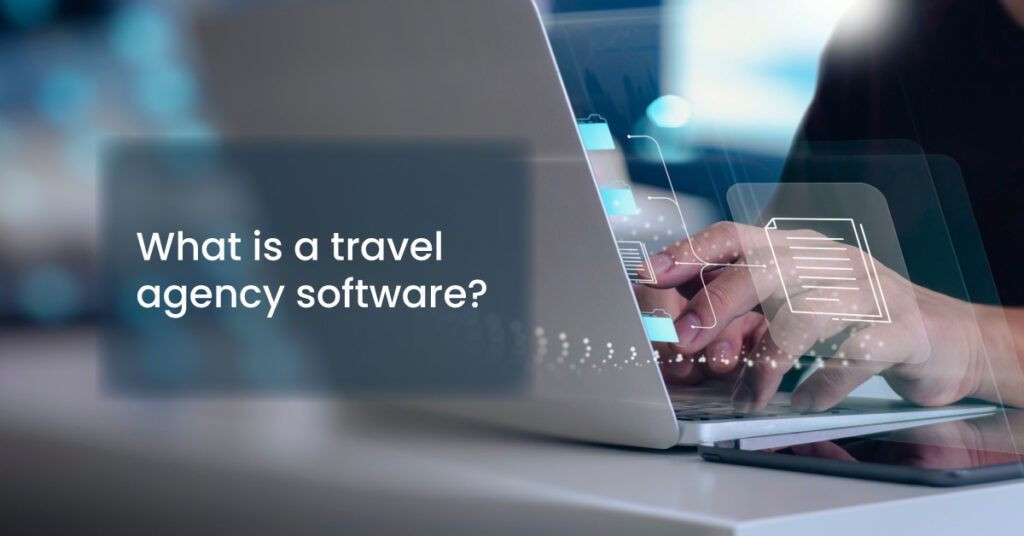
A travel agency software is all-in-one travel-based software that helps you manage and automate your sales, booking, and finances operations. If you are a travel agency, irrespective of your business structure – B2B, B2C, or D2C, a travel agency software is a must for you. However, not all travel agency tools are helpful for your business. The market of service providers is enormous. We are helping you narrow down your choices by listing the features you must look for in travel agency software. But before we get to that, let us just quickly understand the basics of travel agency software. What is travel agency software? Travel agencies have broad portfolios of travel products, including accommodation, travel, transfers, and activities. They need an integrated application to manage both front and back-office activities. A travel agency software works as a nifty tool that helps travel agencies with multiple functions like supplier connectivity, custom pricing, tour package creation, customization, quotes, itinerary creation, etc. Also, a travel agency tool helps travel agencies in their marketing and finance functions either directly or by connecting with other crucial applications travel agencies use for these domains. Though, all the leading travel agency tools offer the functions we discussed above. This article aims to help you with non-negotiable variables of travel agency software – the must-have features of a travel agency application. As we talk through the following key features of the travel agency application, you will better understand where to pull the weight while choosing a software for your travel business. Six must-have features for travel agency software For a product to qualify as a good travel agency tool, it must have the capability to accommodate and manage the varied offerings of a travel agency. Here we are not naming brands for you. Instead, we focus on something more tangible, “the features” which put together constitute a great travel agency software built for growth. So, without further ado, let’s look at these features one at a time: 1. Hotel Contracting All the travel agency applications have a reservation management system. Still, you need a hotel contracting module within your travel agency software to use the reservation system to its true potential. It is the first feature you should check before finalizing the vendor. The reason behind this is simple – irrespective of the size and nature of your travel agency, you will always have a need to upload direct contract hotels. Thus, the hotel contracting module becomes a must. 2. Dynamic Tours Module In today’s world, travel dynamics change quicker than we could imagine. The Covid-19 pandemic was a reminder of the same. So, you need flexibility from the travel agency tool, so you can always customize your offering aligning with the demands of the time – the dynamic tours module of travel agency software gets you that flexibility. 3. Quotation System The quotation module is another key must-have system that must feature in your travel agency tool. The module shall have an exclusive integration capability for agents and travel partners. The system shall allow your agents to simultaneously create multiple quotes for different hotels, tours, flights, and meals. 4. Ticketing and Tracking The ticketing module is the most crucial feature of any travel agency tool. Every travel management tool will have it, yet you need to make sure your software allows you end-to-end tracking of all your confirmed, canceled, redeemed, and issued tickets. 5. User Management System Time is cost, and in an industry like travel, where competition is stiff, you wouldn’t want to lose customers because the travel management system is inefficient. The user management system gives you that desired pace by allowing your customers to quickly log in to your travel portal directly by their social profiles. 6. Integrations Most travel agency tools allow integration with major GDSs, like Amadeus and Sabre, which is a great addition. Yet, your travel agency software must allow third-party supplier integrations like tours, attractions, bed banks, etc. The integrations enable you to access greater volume for your travel agency. Recommended: Top Five Travel Management Software Solutions in 2022 The above list of features is not exhaustive. The services will vary with the providers, but the features mentioned above shall be a great start to your drive to secure the best travel agency application for your business. The larger tip is to get the overall module right. The functions of travel agency software you learned in this piece are a non-negotiable necessity. Anything beyond is cushioning, which you can always trade with your vendor.
Leveraging hotel guest messaging system to enhance customer experience
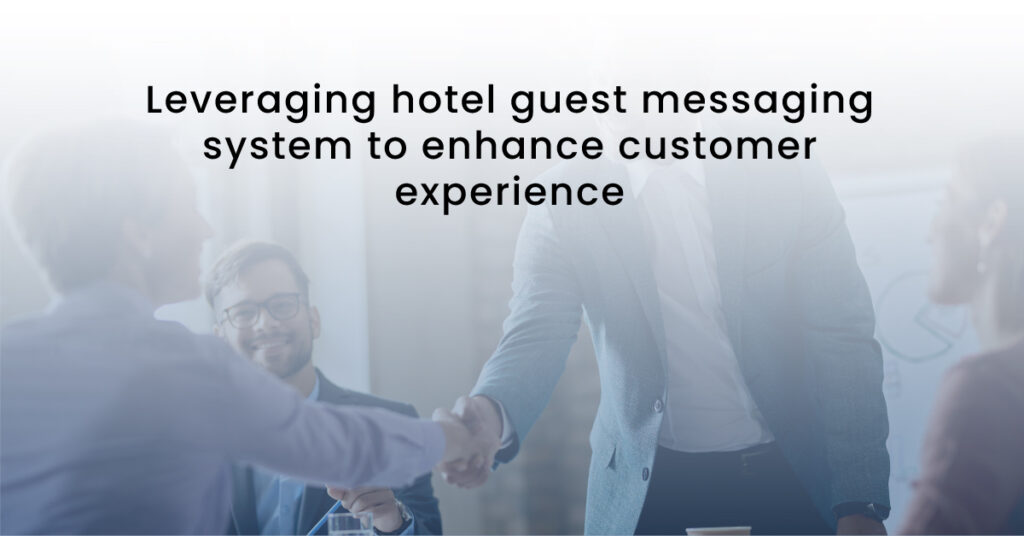
A hotel guest messaging system is a communication platform that allows guests to interact with hotel staff in real time via text messages, voice commands, or chatbot interactions. Hotel guests who use messaging services during their stay rated their overall experience 8% higher than those who did not. A study found that hotels that have implemented messaging systems have seen a 30% decrease in guest complaints. The hospitality industry has never been more competitive than it is today. The good news is that classic differentiators like “customer service” can still put you ahead in the race. While the change is that traditional methods of boosting customer experience are no longer relevant. With guests now having access to a plethora of options and platforms, hotels have to provide an experience that is not only memorable but also convenient and efficient. One way to achieve this is by leveraging a hotel guest messaging system. How does it work? What are things to keep in my while implementing it? What are the prominent use cases and their success rate? We answer all these questions in this blog post. A hotel guest messaging system is a communication platform that allows guests to interact with hotel staff in real-time via text messages, voice commands, or chatbot interactions. This system can be integrated with a hotel’s existing property management system and can be accessed through a guest’s smartphone or tablet, or through a hotel’s in-room tablet or TV. When implementing a hotel guest messaging system, it is important to ensure that the system is easy to use and that guests are made aware of its availability. This can be done by including information about the system in guest check-in packets or by displaying signs in guest rooms and public areas. Additionally, it is important to train hotel staff on how to use the system effectively and efficiently so that they can assist guests with any questions or issues that may arise. Efficiency and Convenience One of the primary benefits of a hotel guest messaging system is that it allows guests to easily access information and assistance without having to wait in line or call the front desk. For example, guests can use the system to request extra towels, ask for restaurant recommendations, or schedule wake-up calls. This can greatly improve the guest experience by providing them with the information and assistance they need quickly and efficiently. According to a study by the Cornell University School of Hotel Administration, guests who use messaging services during their stay rated their overall experience 8% higher than those who did not. Management of guest complaints A ResearchGate report found that hotels that have implemented messaging systems have seen a 30% decrease in guest complaints and a 20% increase in guest satisfaction. Effective Management of Guest Requests and Complaints Another benefit of a hotel guest messaging system is that it can help hotel staff to better manage guest requests and complaints. With all interactions being logged into one central location, staff can easily access and respond to guest inquiries and track their progress in real time. This can help to ensure that all guest requests are handled promptly and professionally, which can lead to improved customer satisfaction Personalization of the Guest Experience A study by Deloitte found that personalized offers result in an average of 20% more revenue per guest. A hotel guest messaging system can also be used to personalize the guest experience by providing guests with tailored recommendations and offers. For example, if a guest is celebrating a special occasion, the system can automatically send them a message offering complimentary champagne or a discount on spa services. This can help create a more memorable and enjoyable experience for guests and increase revenue for the hotel. When it comes to setting up and managing a hotel guest messaging system, you should consider the following: Appoint a dedicated team or person responsible for monitoring and responding to guest messages promptly. Establish clear guidelines and protocols for responding to guest messages, including a script for frequent questions and concerns. Regularly review and analyze data on guest interactions to identify areas for improvement and adjust as needed. A hotel guest messaging system can be a powerful tool for enhancing the customer experience. By providing guests with easy access to information and assistance, and by helping hotel staff to better manage guest requests and complaints, a hotel guest messaging system can help to create a more enjoyable and memorable experience for guests. Additionally, by personalizing the guest experience and providing tailored recommendations and offers, a hotel guest messaging system can also help to increase revenue for the hotel. With the right implementation and training, a hotel guest messaging system can be a valuable asset for any hotel looking to improve customer satisfaction. Vervotech is a leading Hotel Mapping and Room Mapping API that leverages the power of AI and ML to quickly and accurately identify each property listing through the verification of multiple parameters. With One of the industry’s best coverage of 98% and an accuracy of 99.999%, Vervotech is quickly becoming the mapping software of choice for all leading global companies operating in the travel and hospitality industry. To learn more about Vervotech and the ways it can enhance your business in the long run contact us: sales@vervotech.com
Descriptive Content: What is it, and how can it impact the travel company’s revenue?
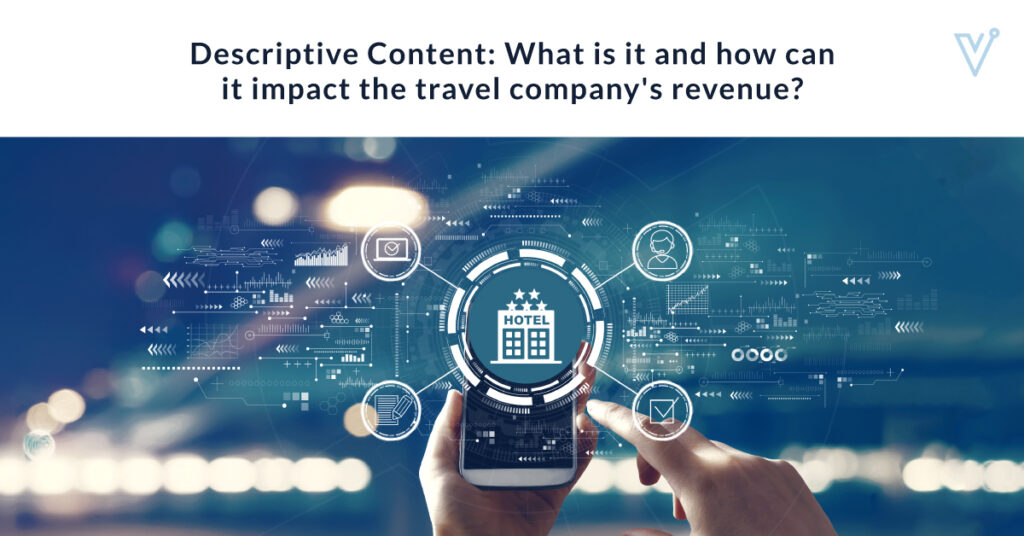
As a travel business, it is great to convert your website’s lookers to bookers- but how do you get your visitors to actually book on your website? Most website visitors don’t book their hotel as soon they find them. Instead, they research and read reviews before making their final purchase decision. Suppose you are a travel company with steady traffic coming from multiple channels but struggle to convert them into your customers. In that case, you need to think about your website’s descriptive content. A website’s descriptive or static content includes hotel information such as hotel name, hotel property photos, hotel amenities, room descriptions, geocodes, hotel policies, and more. Each hotel may showcase the stay experience that they offer by using descriptive content. In fact, descriptive content changes are less frequent than dynamic content but need to be updated regularly. Did you know your website’s descriptive content has the power to increase your website bookings and revenue? Descriptive content or static content significantly impacts travelers’ booking decisions as today’s modern traveler wants accurate and complete information before booking their hotel. So let’s understand in detail descriptive content and its impact on your business revenue. How descriptive content can impact your business revenue If the descriptive content is not regularly updated, then OTAs can face poor customer experience, inaccurate hotel information, missed business opportunities, and revenue losses. Here’s a breakdown of each hotel’s content and how it impacts on your business revenue. 1. Hotel property images According to a study, photography is the most important factor for travelers when scanning for hotels on OTA platforms. High-quality hotel images improve the travel booking experience for customers, which can lead to better booking volumes. Also, another research revealed that better hotel photos receive 150% more traveler engagement. So, if you want better customer engagement, higher booking volumes, then focus on improving the quality of hotel images. 2. Hotel amenities Another descriptive content that can impact your revenue is hotel amenities. If your website showcases the wrong amenities, it can easily impact the traveler’s stay experience. For example, a customer discovered from your website that the hotel property is pet-friendly and books the hotel only to realize reaching the hotel that the property is not pet-friendly. This leads to a dissatisfied guest experience and negatively impacts your brand’s reputation. There are various automation tools that audit the descriptive content of the hotel listings to ensure the customers get what they pay for. 3. Room types There are over 30 different names of hotel rooms, and most hotels categorize hotel rooms based on factors like room size, bed types, interior design, room layout, etc. This can easily confuse the customer during their travel shopping. So, make sure your website is free from duplicate room content through the room mapping tool. Accurate room information gives the customer confidence during booking and increases your brand loyalty, thus increasing your revenue and booking volumes. 4. Geo coordinates and hotel address While geo coordinates are static content, if they are inaccurate for any hotel property listed on your website, it can harm your revenue and brand image. Wrong hotel addresses will lead to bad reviews, dissatisfied customers, and lower booking volumes. Curated content tools powered by AI/ML algorithms can ensure your hotel database has accurate hotel addresses. Improve your descriptive content with Vervotech Curated Content Apart from the mentioned descriptive content, there is over 20+ hotel content that can impact your business revenue too. Our intuitive AI-driven Curated Content tool uses several parameters to identify, segregate and de-duplicate descriptive and illustrative hotel content from multiple suppliers. Below is an example from our curated content tool, which accurately curated the entire hotel descriptive content of Atlantis, The Palm. Image: Vervotech Curated Content Tool Dashboard We even deliver accurate location mapping, such as Hotel to city mapping Point of interest mapping Stadium mapping Train stations mapping Airport mapping As we conclude, if you want your travel business to have a competitive advantage and increase revenue, invest in streamlining descriptive content with automated tools such as curated content. Vervotech Curated Content tool curates over 38 hotel attributes with 99.999% accuracy with 98% coverage so that every accommodation provider delivers a paramount customer experience and gains higher revenue.


